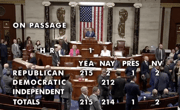A shift in the rental market: Here’s what it could mean for your wallet
- Replies 1
After years of rising rents and shrinking options, renters may finally be seeing a change.
A new report points to a shift that’s catching attention nationwide.
Could this signal a turning point for your budget—and your next move?
In April 2025, median rent for studio to two-bedroom apartments in the 50 largest US metro areas fell by 1.7% year-over-year.
That may not sound like much—but it adds up:
“The result was some major cities that saw a surge in new residents moving in didn't have enough housing to meet the demand, sending rents soaring,” explains Alex Beene, a financial literacy instructor at the University of Tennessee at Martin.
“Now a few years removed, these same metro areas are now dealing with housing availability that more than meets demand and some residents who came during the pandemic returning to their former homes.”

Housing remains the biggest monthly expense for most Americans. The US Department of Housing and Urban Development recommends spending no more than 30% of your income on rent.
The good news? Only four major metro areas are still over that line—including the usual suspects:
But cities like Oklahoma City, Austin, Columbus, and Raleigh? They’re shining with rent-to-income ratios under 20%. That’s affordability we haven’t seen in years.
Also read: Say goodbye to a beloved perk: How Southwest’s shocking policy change will affect your wallet
If you're looking for a studio, now's your moment.
It’s not a fluke. It’s economics.
“Between planning, funding, permitting and building, establishing new multi-family rentals takes substantial time and energy that has finally caught up to demand from the 2020-21 spike in demand,” says Alan Chang, a nationwide title and escrow expert.
“Limited supplies of rentals caused an increased rent, now that the inventory finally met the demand levels, the cost of rent can start to normalize, making rentals more affordable in some areas.”
Still, let’s not get carried away.
“Let's be clear, rent falling is all relative,” adds Kevin Thompson, CEO of 9i Capital Group.
“We've now seen 21 straight months of year-over-year rent declines across the 50 largest metros. Sounds good, right? But here's the catch, median rent is still only about $60 lower than the peak we saw back in August 2022. So yes, prices are cooling, but they're not exactly inexpensive.”
Also read: Will Medicare Advantage audits affect you? What to know about the government’s new crackdown on overpayments
Here’s the straight talk: No, we’re not going back to pre-pandemic rent prices.
“Those expecting prices to return to pre-pandemic levels are mistaken, and this is the new world by which they live,” Thompson warns.
“It is just going to take a larger portion of one's income to rent in this new environment, and as tariffs start to kick in, I would expect those prices to move higher as landlords recoup their insurance and maintenance cost.”
Still, there’s hope on the horizon—especially in the Midwest, where cities like Columbus and Oklahoma City are helping to pull the national average down.
Read next: Are you prepared for the rent hike? How a latest cap proposal might affect your wallet

Have you seen rents drop in your area? Just landed a better lease? Or maybe you remember paying rent in the double digits and want to pass on your wisdom? Share your story in the comments—let’s hear from you.
A new report points to a shift that’s catching attention nationwide.
Could this signal a turning point for your budget—and your next move?
In April 2025, median rent for studio to two-bedroom apartments in the 50 largest US metro areas fell by 1.7% year-over-year.
That may not sound like much—but it adds up:
- Rents are now $60 lower than the all-time high in August 2022 (a 3.4% drop).
- The rent-to-income ratio is down to 23.4%, the lowest in five years.
- Just last year, that number was 24.7%.
“The result was some major cities that saw a surge in new residents moving in didn't have enough housing to meet the demand, sending rents soaring,” explains Alex Beene, a financial literacy instructor at the University of Tennessee at Martin.
“Now a few years removed, these same metro areas are now dealing with housing availability that more than meets demand and some residents who came during the pandemic returning to their former homes.”

After years of sky-high rent hikes and mocking “For Rent” signs in neighborhoods we used to afford, there’s finally a shift. Image Source: Kindel Media / Pexels
Housing remains the biggest monthly expense for most Americans. The US Department of Housing and Urban Development recommends spending no more than 30% of your income on rent.
The good news? Only four major metro areas are still over that line—including the usual suspects:
- New York
- Los Angeles
- Boston
- Miami
But cities like Oklahoma City, Austin, Columbus, and Raleigh? They’re shining with rent-to-income ratios under 20%. That’s affordability we haven’t seen in years.
Also read: Say goodbye to a beloved perk: How Southwest’s shocking policy change will affect your wallet
If you're looking for a studio, now's your moment.
- Median rent for studios dropped $27 compared to last year.
- That’s a 1.9% dip, bringing the national average to $1,410.
It’s not a fluke. It’s economics.
“Between planning, funding, permitting and building, establishing new multi-family rentals takes substantial time and energy that has finally caught up to demand from the 2020-21 spike in demand,” says Alan Chang, a nationwide title and escrow expert.
“Limited supplies of rentals caused an increased rent, now that the inventory finally met the demand levels, the cost of rent can start to normalize, making rentals more affordable in some areas.”
Still, let’s not get carried away.
“Let's be clear, rent falling is all relative,” adds Kevin Thompson, CEO of 9i Capital Group.
“We've now seen 21 straight months of year-over-year rent declines across the 50 largest metros. Sounds good, right? But here's the catch, median rent is still only about $60 lower than the peak we saw back in August 2022. So yes, prices are cooling, but they're not exactly inexpensive.”
Also read: Will Medicare Advantage audits affect you? What to know about the government’s new crackdown on overpayments
Here’s the straight talk: No, we’re not going back to pre-pandemic rent prices.
“Those expecting prices to return to pre-pandemic levels are mistaken, and this is the new world by which they live,” Thompson warns.
“It is just going to take a larger portion of one's income to rent in this new environment, and as tariffs start to kick in, I would expect those prices to move higher as landlords recoup their insurance and maintenance cost.”
Still, there’s hope on the horizon—especially in the Midwest, where cities like Columbus and Oklahoma City are helping to pull the national average down.
Read next: Are you prepared for the rent hike? How a latest cap proposal might affect your wallet
Key Takeaways
- Median rents in major US cities have dropped for the third straight year, now about 3.4% below the August 2022 peak.
- The rent-to-income ratio has fallen to 23.4%, a five-year low—though some cities like Miami still exceed the 30% affordability benchmark. Studio apartments saw the biggest decline, with rents down $27 from last year.
- Experts warn that rents are unlikely to return to pre-pandemic levels, but Midwest cities are leading the way in long-term affordability.
- Inflation, tariffs, and maintenance costs could soon push prices upward again, especially in high-cost coastal markets.






